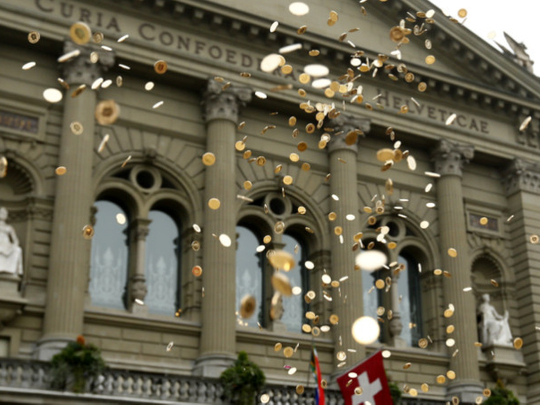
Growth will echo across Switzerland’s mountains next year, thanks to a recovery in Europe and enhanced domestic demand, economic forecasters say. While other parts of Europe are continuing their uphill climb out of recession, economic planners in the Alpine nation are having a better-than-expected time as growth rises and a budget surplus is on the horizon.
After second-quarter growth in the country’s gross domestic product (GDP) expanded 0.5 per cent over the previous quarter, the figure is anticipated to increase further, touching a “pleasing” 1.8 per cent by the end of 2013. Next year, the Swiss economy will post even better figures, crossing the psychological barrier of 2 per cent at an estimated 2.3 per cent, an expert group of the federal government’s State Secretariat for Economic Affairs (Seco) said in a report issued last month.
“Against the background of challenging international economic conditions in 2013, the Swiss economy is therefore proving resilient once again — as it has already done over the past years,” Seco said in a press release.
Dramatic recovery
A group of economists surveyed in a Bloomberg poll concurred with the forecast. According to the media forecast of 27 estimates in the agency’s survey, GDP growth in 2013 is estimated at 1.6 per cent, up from 1.5 per cent. Swiss GDP probably will advance 1.7 per cent next year and 1.9 per cent in 2015, the economists said in the survey.
The new prediction is an update from previous growth figures of 1.4 per cent for 2013 and 2.1 per cent for 2014. The country is profiting from low interest rates, the absence of inflation and steady levels of immigration, which in combination produce a robust domestic economy.
“Improvement is expected as the international economy, in particular the recovery, which is beginning to take root in the Euro region, is likely to provide a positive impetus. By contrast, a dramatic recovery in the export industry, which showed itself to be particularly resistant in recent years, is still slow in coming,” the Seco statement said.
Seco based much of its revised outlook on improved prospects for the crisis-ridden Eurozone, which is Switzerland’s largest trading partner.
In 2014, the expectation is for a broadly based economic recovery, extending to exports and the labour market — although a broadly based upturn is some way off. On the positive side, private consumption has provided strong support for the economy for several quarters, investment in construction is positive and tourism exports are in recovery mode. On the other hand, goods exports are continuing to suffer from the subdued sales markets, particularly in the European Union, prompting below-average capacity utilisation in the industry sector.
Steady rise
Unemployment is also likely to see a gradual downward reversal next year as the economy firms up. Since the growth in the level of employment was insufficient to absorb the rising supply of work, unemployment levels showed a slight though steady rise for around two years.
“However, there are currently initial signs that the rise in (seasonally adjusted) unemployment could come to an end over the coming months. In the year ahead the stronger economy is then likely to produce a gradual reduction in unemployment figures during the course of the year. The expert group anticipates annual average unemployment levels of 3.2 per cent for 2013 and 2014 respectively, slightly below the previous forecast (3.3 per cent respectively for both years),” Seco said. >
Also helping to shield the economy is the Swiss National Bank’s (SNB) cap on the franc of 1.20 per euro. Set two years ago after the safe haven currency was pushed close to parity with the euro, the cap is viewed as responsible for keeping the economy to a single quarter of contraction since its introduction, as against the surrounding euro area, which emerged from recession only last year.
Receding risks
On September 19 the Zurich-based central bank retained the cap, vowing to defend it with unlimited currency interventions. “At the moment there’s no reason to discuss an exit of the cap — the minimum exchange rate is still very important. How long that will be the case is hard to predict,” Thomas Jordan, President, SNB, was quoted by Bloomberg as saying in a media interview after the bank’s quarterly policy review.
Officials also left the band for the benchmark interest rate unchanged at zero per cent to 0.25 per cent. “The global recovery is very slow,” Jordan added, citing “a possible resurgence of Europe’s debt crisis, geopolitical tensions in the Middle East and a potential slowdown in emerging markets as grounds for caution. “The risks may have receded, but they’ve not disappeared”.
In its report, Seco identified the Eurozone debt crisis as the greatest economic risk for Switzerland. “Despite the calmer financial markets the crisis cannot be considered as having been overcome because the Eurozone countries of Southern Europe are still a relatively long way from achieving any far-reaching economic (structural) improvement. Growing social tensions and lack of political unity could jeopardise the necessary economic reforms both in the individual countries as well as on the European level (unresolved implementation of banking union),” the Seco statement said.
Such a scenario could lead to renewed uncertainty on the financial markets and ultimately place a further drag on the economic recovery in the Eurozone, with the franc facing renewed upward pressure against the euro.
Among other risks, the body further highlighted slower-than-expected growth in emerging countries as well as the possibility of overheating on Switzerland’s real estate market, historically extremely attractive.


